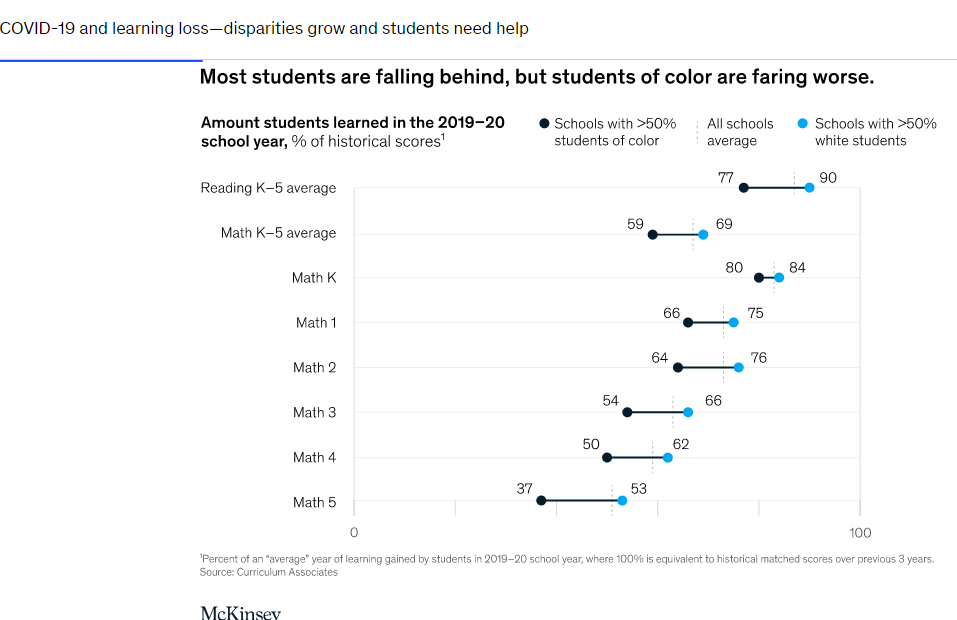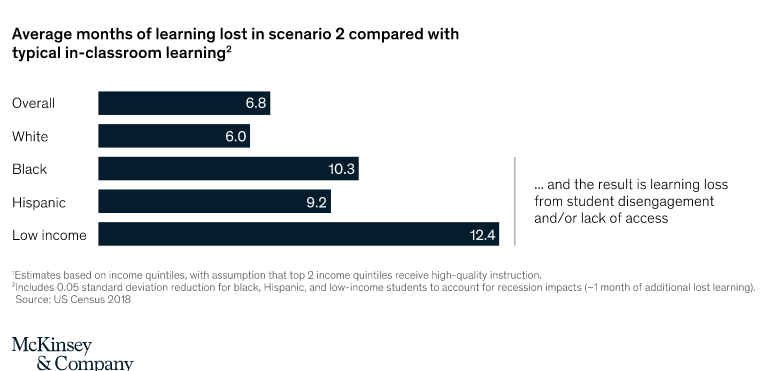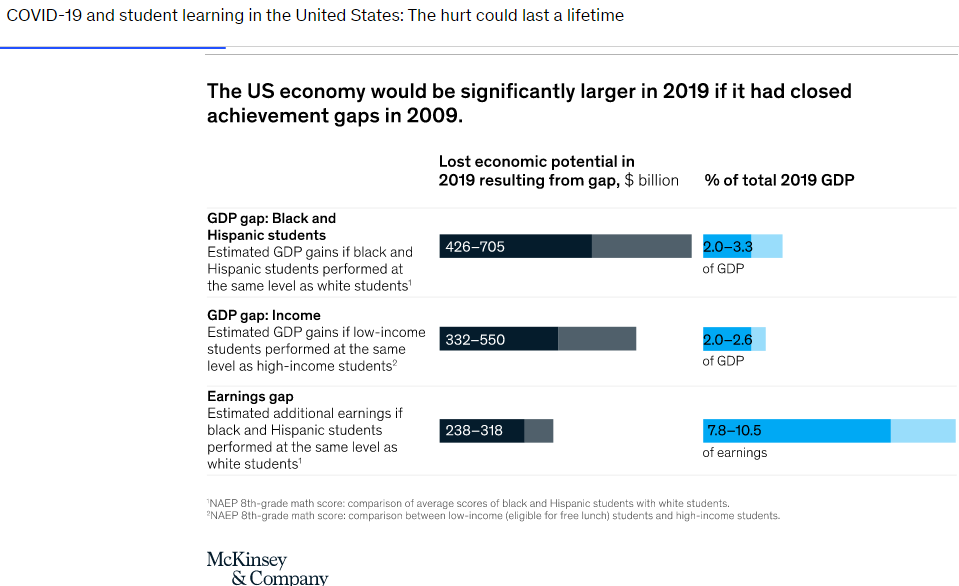- What impact does the COVID-19 pandemic have on the lives, livelihood and academic achievement of students of color?
- How does the impact translate into futuristic barriers and challenges for students of color?
- How can the implementation of a community service initiative help to lessen the academic disparity amongst at risk students in a given community?
Since the outbreak of COVID-19, there has been a plethora of research to see how we can come in front of these unprecedented times. Investigations have examined the impact of the COVID-19 pandemic across race and ethnicities, particularly as it relates to education. As such, this research seeks to hone in on the findings of these research to amalgamate findings necessary for providing solutions lessening the widening academic achievement gap for students of color.

Findings have shown that while all students have experienced significant learning loss, students of color have fared worse. COVID-19 academic impact have fallen unequally as well as deepened historical disparities and consequently, generational educational opportunities and achievement. When compared to their white peers, students of color face a more daunting learning loss and widening of academic disparity as a result of undesirable learning conditions, inadequate tools and insufficient support systems. Undoubtedly, the shut down of schools compounded these situations as disadvantaged students who struggled the hardest to learn and thrive under normal circumstances, finds even impossible to learn in such traumatic times.
“Emergencies lead to undeniably negative impacts on educational processes and outcomes; the most disadvantaged population subgroups experience the largest, and most lasting, negative consequences; and contingency plans—absent during the ongoing pandemic—are of critical importance. Providing education, often made available because of these plans, leads to positive outcomes to children and societies. Moreover, emergencies tend to strain existing resources, adding additional challenges.” (Garcia et al. 2020)


Undisputable, not all Black children and youth are academically disadvantaged, nor all White children and youth are academically privileged. However, proportionally Black children and youth are disproportionately disadvantaged which raises concern for societal success due to a generational presence of opportunity gaps. Hence, opportunity gap is a serious issue with devastating consequences for the future of disadvantaged students. The term “opportunity gap” refers to any significant and persistent differences in academic performance between different groups of students. Groups are based on categories such as ethnicity, race, gender, disability, and income. Opportunity gaps are typically measured by standardized tests and there are evident gaps in test scores among many different groups of students. Test score gaps often lead to longer-term gaps, including high school and college dropout rates as well as employment as an adult. The National Education Association has found that, “Despite decades of overall progress in narrowing the achievement gaps, disparities in educational outcomes related to poverty, English language proficiency, disability, and racial ethnic background still persist.”
“Black people continue to face structural barriers to opportunities in the U.S.” (Shapiro, 2017). “Research reveals that the U.S. is hierarchically designed to rank and privilege those of European descent to the disadvantage of Black people (Hartney & Flavin, 2013); Lipman, 2013, 2011). This sociopolitical structure highlights the dearth of resources and opportunities for quality education. This ultimately disadvantage the average Black youth; (Darling-Hammond, 2007b; Erickson,2016; Knaus, 2007; Orfield et al., 2012) “and create a pipeline into the criminal justice system (Ewert et al., 2014; Nybell, Shook, & Finn, 2009). These performance gaps reflect extensive unmet needs and thus untapped talents among low-SES children. The development of strong cognitive and noncognitive skills is essential for success in school and beyond. Low educational achievement leads to lowered economic prospects later in life, perpetuating a lack of social mobility across generations. It is also a loss to society when children’s talents are allowed to go fallow for lack of sufficient supports. The undeniable relationship between economic inequalities and education inequalities represents a societal failure that betrays the ideal of the “American dream.” (Garcia, & Weiss, 2017).
The Black race is often ranked at the bottom of the racial hierarchy to achieve the stratification function of the capitalist society that promotes the racist ideology of domination and subordination (Bonilla-Silva, 2015; Tomlin et al., 2013). Schools, through racialized norms and practices such as discipline policies and test scores, may potentially serve to achieve capitalistic sorting and placement strategies (Bell, 1995; Erickson, 2016; Tomlin et al. 2013). With the state and its institutions, education included, being the framework for achieving capitalist goals for individuals to be accorded the rights and privileges of access to citizenship to be able to participate in society as successful citizens. “The U.S. social structure achieves the ideals of modern capitalism – which privilege Whiteness and disadvantage Blackness (Battalora, 2013; Bell, 1995; Harris, 1993) – through its various institutions including the public school system, which is arguably one of the most powerful state apparatuses for disqualifying many Black youth to sustain the interest of the capitalistic society. (Bell, 1995; Erevelles, 2000; Tomlin et al., 2013).
As it concerns education, children’s socioeconomic status (SES), of which income is a key component, is considered one of the most significant predictors—if not the most significant predictor—of educational success. Numerous studies show the strength of the relationship between social class (of which socioeconomic status is a frequent measure), test scores, educational attainment, and college attendance and completion (see Duncan, Morris, and Rodrigues 2011; García 2015; García and Weiss 2015; Lee and Burkam 2002; Mishel et al. 2012; Putnam 2015; among others). As a result of these trends and associations, achievement gaps by social class have grown substantially since the 1960s, especially between children at the highest end of the income distribution and all of the others (Reardon 2011).
With that said, it goes without saying that low achieving Black youth in particular face barriers in the capitalist market, which subsequently challenge their competency and ability to function within the middle-class norms of most organizations. Children of certain ethnic and racial minorities who are disproportionately likely to live in concentrated poverty are also more likely to do so over prolonged periods of time (Sharkey 2013). And the close connections between education inequalities and economic inequalities cast doubt on assertions that America provides “equality of opportunities” that promotes social mobility (Mishel 2015). The influence of income inequality affects multiple aspects of society’s functioning, from health outcomes and even life expectancy to democratic ideals (Putnam 2015; Schanzenbach et al. 2016; Stringhini et al. 2017).

In an effort to close the opportunity gaps and by and large the academic gap of a select community, a community initiative will be created to provide a “full-service community school”. In partnering and coordinating with local service providers, the City of Lauderdale Lakes and the Kiwanis Club of Lauderdale Lakes, this service initiative will provide some daily, weekly, and quarterly events and services that supports the community at large. These include but are not limited to:
- Parent Universities – to empower parents
- Positive social-emotional experiences
- Supportive family and community events
- Family engagement events
- Academic enrichment
- Afterschool programs
- Summer programs
- Mentoring programs
- Career Planning events/programs
These findings are disturbing but not surprising! During COVID classes were virtual and my role was to assist the teachers with attendance (to call parents to let them know their child haven’t been in school or logged on), technical issues, support with the lesson and behavior problems while the teachers taught the lesson. I thought this task would be easy but it was difficult for me as an adult to try and navigate through these issues and be an assistance to the teachers as well as the students and parents.
I also noticed that the black students attendance rate were lowest than any other ethnicity group. Black students did not have an adults home to assist them with their work or to encourage them to log on. We must put something in place to close the gap between the black students and the other races during COVID.